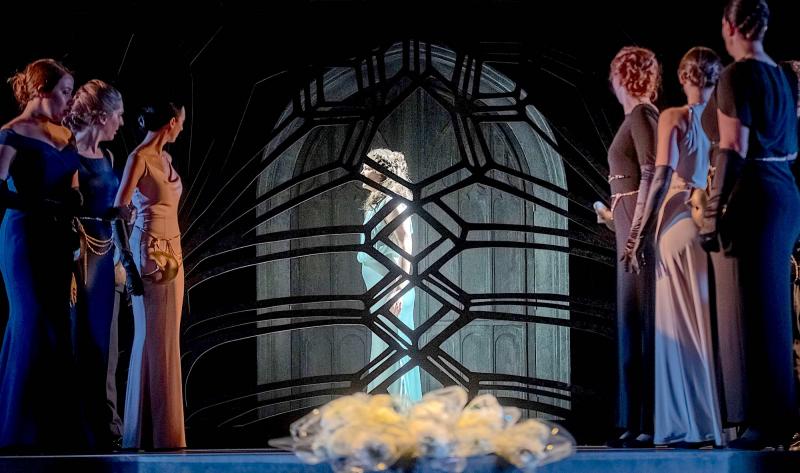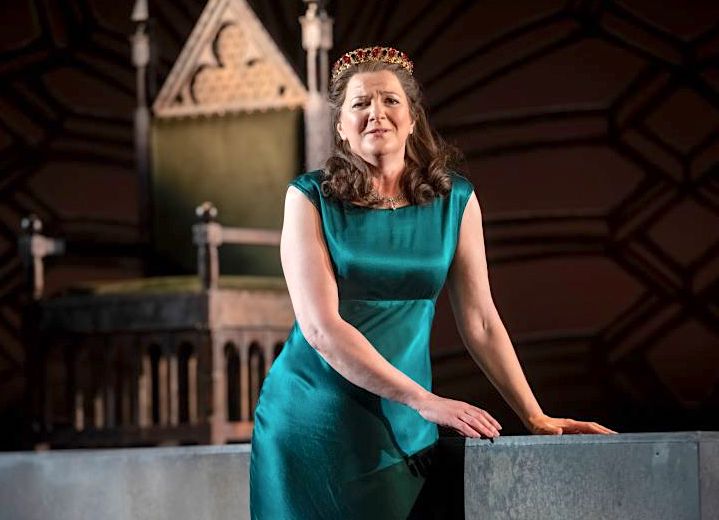Anna Bolena, Longborough Festival Opera review - Henry VIII's court becomes a sexualised death cult | reviews, news & interviews
Anna Bolena, Longborough Festival Opera review - Henry VIII's court becomes a sexualised death cult
Anna Bolena, Longborough Festival Opera review - Henry VIII's court becomes a sexualised death cult
The Gloucestershire Bayreuth delivers a bel canto thriller

Divorced, beheaded, died; divorced, beheaded, survived. Anne Boleyn is number two on the list, so anyone who can remember even that much Tudor history can guess that Donizetti’s Anna Bolena is not going to end well.
By that measure, Jenny Miller’s new production for Longborough Festival Opera scores handsomely. The atmosphere is sinister, and spotlights roam the stage as the overture plays. Nate Gibson’s set design is dominated by a fretwork screen whose swirls and curves echo a Tudor decorative ceiling: the bars of a seductively beautiful cage. The inhabitants of this world wear contemporary formal wear, and Anne Boleyn (Linda Richardson, pictured below) is every bit as soignée in her emerald silk number as Jane Seymour (Caryl Hughes) in her bright red gown and evening gloves – at first, anyway. As they strut and strike poses, they’re far too impressed with themselves to realise that they’re trapped, and Miller deftly helps the audience stay one step ahead of the characters.
 So a dancer with the head of a doe is trapped and killed by a crowd of hunters while, in the foreground, Lukas Jakobski’s strapping (vocally as well as physically) Henry VIII toys with his human prey. At the end of the first scene, Jakobski (pictured below with Hughes) carries the petite Hughes offstage: a big bully with his latest human toy. And the chorus wear gold carnival masks, because…well, entering the theatre, we were each handed a copy of WB Yeats’s poem The Mask: “It was the mask engaged your mind / And after set your heart to beat / Not what’s behind”. Directorial crib sheets feel a bit like cheating, but the masks, combined with the nocturnal lighting, certainly helped generate that Eyes Wide Shut sensation of being locked into in a sexualised death cult: not a bad description of the court of Donizetti’s psychopathic, all powerful Henry.
So a dancer with the head of a doe is trapped and killed by a crowd of hunters while, in the foreground, Lukas Jakobski’s strapping (vocally as well as physically) Henry VIII toys with his human prey. At the end of the first scene, Jakobski (pictured below with Hughes) carries the petite Hughes offstage: a big bully with his latest human toy. And the chorus wear gold carnival masks, because…well, entering the theatre, we were each handed a copy of WB Yeats’s poem The Mask: “It was the mask engaged your mind / And after set your heart to beat / Not what’s behind”. Directorial crib sheets feel a bit like cheating, but the masks, combined with the nocturnal lighting, certainly helped generate that Eyes Wide Shut sensation of being locked into in a sexualised death cult: not a bad description of the court of Donizetti’s psychopathic, all powerful Henry.
Jakobski played him with chilling detachment – face twisting with curdled entitlement as he sees his will thwarted, then nervously buttoning up his blazer as his morality is challenged. His voice, soft-grained at first, grew throughout the performance into a force of quiet terror, rising to a black toned roar. Hughes, as Jane, was initially almost a match for him, prising away at his resolve with a tight, springy, slightly plangent soprano; a sound, coupled to an insinuating performance, which would later make a nicely revealing contrast with Richardson’s altogether warmer Anne. But then, everyone came off most vividly when paired with Richardson: whether Carolyn Dobbin’s ardent Smeaton, or Jung Soo Yun’s raw but agile tenor as Percy – never more persuasive than when blending with Richardson, or powering through an ensemble on lacerating full-beam.
 But it says Anna Bolena on the tin, and boy, Anne Boleyn was what we got. Richardson delivered a central performance of compelling subtlety and emotional realism. As her character’s arrogance turned to disbelief, defiance and finally delusion, Richardson’s voice shaded almost by the phrase from fragility to steely strength. Defiant snarls uncoiled into glowing richness, and sudden, magnesium flashes of coloratura threw whole ensembles into bold profile. The orchestra, under Jeremy Silver, found colours to match; piccolo highlighting the unfolding horror in fluorescent marker while glowing horns and smoky oboes offered the illusion of consolation. Silver knows how to generate the authentic, accelerating thrill of a Donizetti cabaletta too.
But it says Anna Bolena on the tin, and boy, Anne Boleyn was what we got. Richardson delivered a central performance of compelling subtlety and emotional realism. As her character’s arrogance turned to disbelief, defiance and finally delusion, Richardson’s voice shaded almost by the phrase from fragility to steely strength. Defiant snarls uncoiled into glowing richness, and sudden, magnesium flashes of coloratura threw whole ensembles into bold profile. The orchestra, under Jeremy Silver, found colours to match; piccolo highlighting the unfolding horror in fluorescent marker while glowing horns and smoky oboes offered the illusion of consolation. Silver knows how to generate the authentic, accelerating thrill of a Donizetti cabaletta too.
Not so much at the outset, perhaps, where the orchestra sounded reluctant to snap into the Italianate style (to be fair, they’ve just come straight out of the soul shaking experience of Anthony Negus’s Rheingold). But by the end of Act One, everything was boiling up nicely. Act Two’s central Council scene had the pace and muscular tension of a courtroom thriller, and if a couple of Miller’s visual metaphors didn’t exactly come off – there was a curious business with the chorus pointing mirrors at Henry, to no perceptible effect, and the timing of the executioner’s sword needed tightening up – the musical performances were by now wholly inside the drama’s nightmare world.
Henry and Jane’s wedding march was a raucous leer of hollow triumph. And Richardson found yet another new vocal colour before the final chop: a haunting, veiled sound, glowing from within, as the unhappy Anne escapes into delusion. Even at this stage, some part of me was still holding out for a happy ending – which, as far as this opera is concerned, means job done.
rating
Explore topics
Share this article
The future of Arts Journalism
You can stop theartsdesk.com closing!
We urgently need financing to survive. Our fundraising drive has thus far raised £49,000 but we need to reach £100,000 or we will be forced to close. Please contribute here: https://gofund.me/c3f6033d
And if you can forward this information to anyone who might assist, we’d be grateful.

Subscribe to theartsdesk.com
Thank you for continuing to read our work on theartsdesk.com. For unlimited access to every article in its entirety, including our archive of more than 15,000 pieces, we're asking for £5 per month or £40 per year. We feel it's a very good deal, and hope you do too.
To take a subscription now simply click here.
And if you're looking for that extra gift for a friend or family member, why not treat them to a theartsdesk.com gift subscription?
more Opera
 Albert Herring, English National Opera review - a great comedy with depths fully realised
Britten’s delight was never made for the Coliseum, but it works on its first outing there
Albert Herring, English National Opera review - a great comedy with depths fully realised
Britten’s delight was never made for the Coliseum, but it works on its first outing there
 Carmen, English National Opera review - not quite dangerous
Hopes for Niamh O’Sullivan only partly fulfilled, though much good singing throughout
Carmen, English National Opera review - not quite dangerous
Hopes for Niamh O’Sullivan only partly fulfilled, though much good singing throughout
 Giustino, Linbury Theatre review - a stylish account of a slight opera
Gods, mortals and monsters do battle in Handel's charming drama
Giustino, Linbury Theatre review - a stylish account of a slight opera
Gods, mortals and monsters do battle in Handel's charming drama
 Susanna, Opera North review - hybrid staging of a Handel oratorio
Dance and signing complement outstanding singing in a story of virtue rewarded
Susanna, Opera North review - hybrid staging of a Handel oratorio
Dance and signing complement outstanding singing in a story of virtue rewarded
 Ariodante, Opéra Garnier, Paris review - a blast of Baroque beauty
A near-perfect night at the opera
Ariodante, Opéra Garnier, Paris review - a blast of Baroque beauty
A near-perfect night at the opera
 Cinderella/La Cenerentola, English National Opera review - the truth behind the tinsel
Appealing performances cut through hyperactive stagecraft
Cinderella/La Cenerentola, English National Opera review - the truth behind the tinsel
Appealing performances cut through hyperactive stagecraft
 Tosca, Royal Opera review - Ailyn Pérez steps in as the most vivid of divas
Jakub Hrůša’s multicoloured Puccini last night found a soprano to match
Tosca, Royal Opera review - Ailyn Pérez steps in as the most vivid of divas
Jakub Hrůša’s multicoloured Puccini last night found a soprano to match
 Tosca, Welsh National Opera review - a great company reduced to brilliance
The old warhorse made special by the basics
Tosca, Welsh National Opera review - a great company reduced to brilliance
The old warhorse made special by the basics
 BBC Proms: The Marriage of Figaro, Glyndebourne Festival review - merriment and menace
Strong Proms transfer for a robust and affecting show
BBC Proms: The Marriage of Figaro, Glyndebourne Festival review - merriment and menace
Strong Proms transfer for a robust and affecting show
 BBC Proms: Suor Angelica, LSO, Pappano review - earthly passion, heavenly grief
A Sister to remember blesses Puccini's convent tragedy
BBC Proms: Suor Angelica, LSO, Pappano review - earthly passion, heavenly grief
A Sister to remember blesses Puccini's convent tragedy
 Orpheus and Eurydice, Opera Queensland/SCO, Edinburgh International Festival 2025 review - dazzling, but distracting
Eye-popping acrobatics don’t always assist in Gluck’s quest for operatic truth
Orpheus and Eurydice, Opera Queensland/SCO, Edinburgh International Festival 2025 review - dazzling, but distracting
Eye-popping acrobatics don’t always assist in Gluck’s quest for operatic truth
 MARS, Irish National Opera review - silly space oddity with fun stretches
Cast, orchestra and production give Jennifer Walshe’s bold collage their all
MARS, Irish National Opera review - silly space oddity with fun stretches
Cast, orchestra and production give Jennifer Walshe’s bold collage their all

Add comment